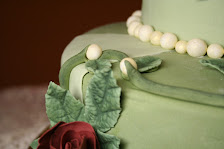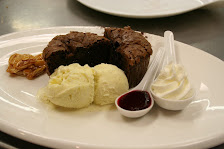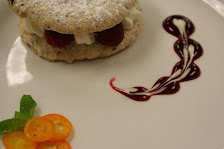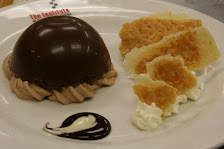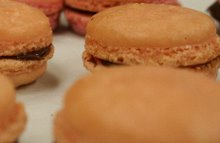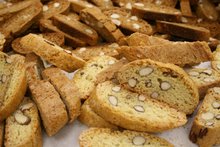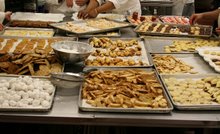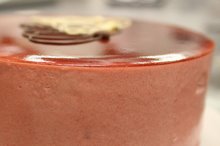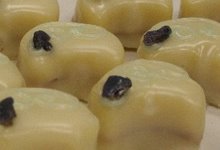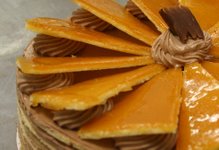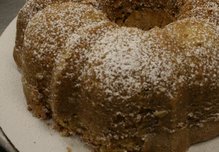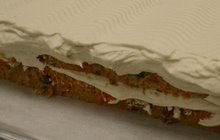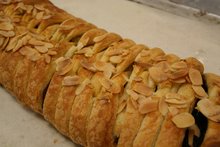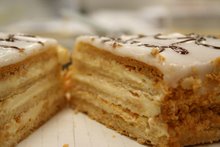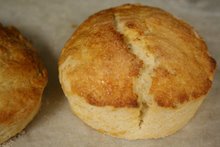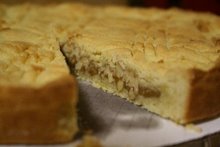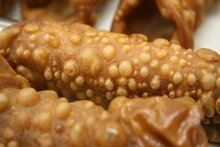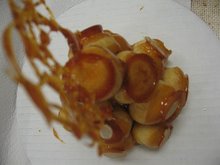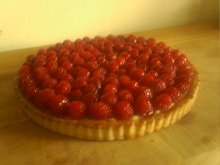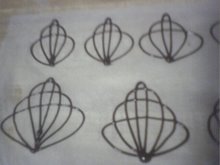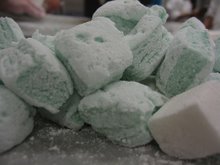Day 15: More business. More tasting. More tests.
Our lecture continued this evening, and the prospect of taking the management course settled squarely into my mind, the wisdom of it having become apparent. Whether or not I will continue with that course when I have finished Pastry remains to be seen. One thing is certain: I’d write less. While the business management material is fascinating and tremendously important, writing about it would be far less stimulating, both, I would imagine, from my perspective and from yours.
After the lecture had concluded, we briefly tasted and identified a number of flours. Telling cake flour apart from rye is not a great stretch; however, identifying which of two flours is all-purpose flour and which is bread flour proves somewhat more difficult. Chef promised, however, that doing so will be second nature by the time that this very question comes up on our Module One practical exam, which, stunningly, is nearly upon us. He also mentioned that he will not be teaching us for Module Two (of four), which was enormously depressing to almost all of us. I’m certain our Module Two instructor will be excellent, but our current chef is the one who introduced us to the school, the business, and the craft. We’ve formed a familial bond with him, and, regardless of who follows, I’m sure his influence will be a strong hand throughout my career.
Chef went through each question that will appear on our second quiz, shortly after we return from the holiday week. He also went over certain details, such as the one I mentioned above, about our final exam, which will occur after just ten more lessons. My family will have the unadulterated pleasure of watching me practice cornet work over the coming week; I've taken several pounds of chocolate and a ream of parchment paper with which to practice, so that by the time this also appears on our exam, I will feel at least at the first-grade level.
It’s scary to think of our exam, perhaps, but it’s even more frightening to consider that after two more weeks of class and one exam, we will be a quarter of the way into the program. Time is moving startlingly quickly. Chef also mentioned that the time for chit-chat and early nights has passed, and that when we return, the workload will be redoubled.
To entertain you during this time of less-than-average material, I’ve added some photos, courtesy of my classmate Lana. Please enjoy them.
Happy Holidays!
Friday, December 22, 2006
Wednesday, December 20, 2006
Day 14: Business. Unmolding.
The second segment of today’s lesson involved unmolding our panna cotta of the other day, and unwrapping and tasting our gelée. The panna cotta came out quite nicely, if a little too firm and spongy. It most certainly lost moisture, since we completely forgot to wrap or cover it, and it had been sitting in a high-traffic refrigerator for forty-eight hours.
Champagne and mint gelée, the invention of which we were so smugly proud, was much more fun to look at than to eat. It tasted like what you might expect if you went into your great-grandmother’s attic and found a really old, dusty book, and opened it as quickly as possible while inhaling sharply. It was rather depressing, but in all honesty it would have been a little surprising if two pastry students had invented a jaw-dropper in their fourth week of school. At least now we know the reason none of us has ever heard of this dessert.
The first three-quarters of class was a discussion with the director of the school’s Culinary Management program, followed by an hour-long tide of personal questions to Chef. The management lecture and discussion were very informative, and the importance of the topic was lost on no one in the class. However, it was not as materially exciting as lessons in which we fling meringue at one another or drag our sleeves through freshly-piped chocolate designs. Thus lacking anything with which to amuse you further, I shall conclude early this evening.
And skip dessert.
The second segment of today’s lesson involved unmolding our panna cotta of the other day, and unwrapping and tasting our gelée. The panna cotta came out quite nicely, if a little too firm and spongy. It most certainly lost moisture, since we completely forgot to wrap or cover it, and it had been sitting in a high-traffic refrigerator for forty-eight hours.
Champagne and mint gelée, the invention of which we were so smugly proud, was much more fun to look at than to eat. It tasted like what you might expect if you went into your great-grandmother’s attic and found a really old, dusty book, and opened it as quickly as possible while inhaling sharply. It was rather depressing, but in all honesty it would have been a little surprising if two pastry students had invented a jaw-dropper in their fourth week of school. At least now we know the reason none of us has ever heard of this dessert.
The first three-quarters of class was a discussion with the director of the school’s Culinary Management program, followed by an hour-long tide of personal questions to Chef. The management lecture and discussion were very informative, and the importance of the topic was lost on no one in the class. However, it was not as materially exciting as lessons in which we fling meringue at one another or drag our sleeves through freshly-piped chocolate designs. Thus lacking anything with which to amuse you further, I shall conclude early this evening.
And skip dessert.
Tuesday, December 19, 2006
Day 13: Outing.
I’ve been a naughty, naughty boy. I will never know what I have done to deserve an evening of such unrestrained decadence. But it was a very sweet evening.
We arrived at our posh restaurant, to eat dessert first, at six o’clock. In short order, the alumna who was their pastry chef came out, introduced herself, and answered our preliminary questions. She very kindly had them send us out a bottle of sparkling wine to take the sweet edge off the desserts we were tasting.
We began with the cake, fruit, and custard desserts, such as gingerbread spiced donuts with cranberry compote and vanilla ice cream, plates of warm cookies with hot chocolate, apple strudel with ginger wafers and cinnamon caramel ice cream, blood orange mousse topped with meringue and served with blood orange sorbet, apple sundae (the only one I found to be too sweet). The favorites of this first round were generally the maple crème caramel with pear sorbet, and the mascarpone-yogurt cheesecake with pineapple fritters and cashew-brittle ice cream. Also popular was the plate of four varieties of sorbet: blood orange, pear, concord grape, and quince. The value of a cheese plate on a dessert table became very apparent, as all of us needed something to offset the barrage of sweetness. The cheeses were excellent, and well-chosen. They weren’t too strong, but sharp and salty enough to cleanse and refresh our now beleaguered palates – or at least distract them.
We all sat back, sated completely but oddly relieved that dessert was over. Until they brought out the chocolate desserts. This second round brought chocolate-peanut butter icebox cake with banana ice cream, chocolate-hazelnut napoleons with praline ice cream, molten chocolate-peanut butter cake with chocolate-peanut butter ice cream, peanut butter-chocolate roll, chocolate-peanut butter roll… the parade was too long to recount everything that floated by, but we were all pining for large pieces of salty beef by this point, full though we were.
This was decidedly the heaviest tasting yet, and despite the public setting we did manage to learn quite a bit. The chef was quite congenial and patiently answered all of our questions, even the one I managed to eek out: “Do you, like, totally, love it?” (What a moron!) We noted in particular that although the décor of this extremely upscale restaurant was very sleek and modern – somewhat akin to a large wooden jet fuselage with a honeycomb theme – the desserts themselves were presented in a very down-home style. This isn’t to say that they weren’t plated beautifully; they were. They just weren’t overtly fanciful. We all tasted far more than we ought to have. But hopefully the gain won’t be just weight. I, for one, realized that in just four short weeks, my palate has begun to develop new abilities, not only to taste subtler flavors in things, but also to detect nuances in texture and composition. Maybe all these agonizing tastings are actually doing something more than leaving me with red marks around my waist at night.
Now I’m going to go find some nice, refreshing ham.
I’ve been a naughty, naughty boy. I will never know what I have done to deserve an evening of such unrestrained decadence. But it was a very sweet evening.
We arrived at our posh restaurant, to eat dessert first, at six o’clock. In short order, the alumna who was their pastry chef came out, introduced herself, and answered our preliminary questions. She very kindly had them send us out a bottle of sparkling wine to take the sweet edge off the desserts we were tasting.
We began with the cake, fruit, and custard desserts, such as gingerbread spiced donuts with cranberry compote and vanilla ice cream, plates of warm cookies with hot chocolate, apple strudel with ginger wafers and cinnamon caramel ice cream, blood orange mousse topped with meringue and served with blood orange sorbet, apple sundae (the only one I found to be too sweet). The favorites of this first round were generally the maple crème caramel with pear sorbet, and the mascarpone-yogurt cheesecake with pineapple fritters and cashew-brittle ice cream. Also popular was the plate of four varieties of sorbet: blood orange, pear, concord grape, and quince. The value of a cheese plate on a dessert table became very apparent, as all of us needed something to offset the barrage of sweetness. The cheeses were excellent, and well-chosen. They weren’t too strong, but sharp and salty enough to cleanse and refresh our now beleaguered palates – or at least distract them.
We all sat back, sated completely but oddly relieved that dessert was over. Until they brought out the chocolate desserts. This second round brought chocolate-peanut butter icebox cake with banana ice cream, chocolate-hazelnut napoleons with praline ice cream, molten chocolate-peanut butter cake with chocolate-peanut butter ice cream, peanut butter-chocolate roll, chocolate-peanut butter roll… the parade was too long to recount everything that floated by, but we were all pining for large pieces of salty beef by this point, full though we were.
This was decidedly the heaviest tasting yet, and despite the public setting we did manage to learn quite a bit. The chef was quite congenial and patiently answered all of our questions, even the one I managed to eek out: “Do you, like, totally, love it?” (What a moron!) We noted in particular that although the décor of this extremely upscale restaurant was very sleek and modern – somewhat akin to a large wooden jet fuselage with a honeycomb theme – the desserts themselves were presented in a very down-home style. This isn’t to say that they weren’t plated beautifully; they were. They just weren’t overtly fanciful. We all tasted far more than we ought to have. But hopefully the gain won’t be just weight. I, for one, realized that in just four short weeks, my palate has begun to develop new abilities, not only to taste subtler flavors in things, but also to detect nuances in texture and composition. Maybe all these agonizing tastings are actually doing something more than leaving me with red marks around my waist at night.
Now I’m going to go find some nice, refreshing ham.
Day 12: Jell-O. Jet-Puffed. Cool Whip.
Today’s lesson began with the revelation that some restaurants charge you a lot of money for a dessert called gelée, which is to say, Jell-O. There is more gelatine in the prepackaged variety, so it gets a bit firmer, and making your own from scratch is fifteen seconds slower; these seem to be the cardinal differences between the two. With a sigh of collective disappointment, we shelved the idea of starting class with a cornet session so our gelée would have time to firm up by the end of class.
It turns out that the Jell-O people aren’t that far off, if we assume that what we made tonight was the real thing. Who could forget the craze that started a few years ago, when people began using Champagne (or, more probably, “champagne”) as the liquid in their holiday Jell-O creations? (I seem to recall that it was right around the time that the good folks at Jell-O came out with the White Grape flavor. No disrespect to Jell-O, but Champagne is already flavored like white grapes.) The conflict here, then, is forcing ourselves, some of us who have been labeled “food snobs,” to do one of two things: either we ignore the fact that we consider gelée fancy and Jell-O not, or we allow our estimation of Jell-O to be elevated a bit. I think I’ll choose the latter, if only because it’s satisfying to admit I can allow for some personal growth.
The one freedom gelée-making does allow us, though, is choice of flavors. We were warned off the recipe in our texts for Belgian beer gelée; Chef said that although it sounds intriguing to almost everyone it tends to be the one most often left behind. I suppose it makes sense, since nothing would offend the sensibilities of a Belgian beer lover like tossing in a bunch of sugar. What my new partner this week and I decided to do was make a two-layer gelée (this is sounding more like a church picnic all the time, isn’t it?), the lower layer of which was Champagne gelée, the upper, Champagne and mint gelée. It wasn’t set before class finished, but if it’s as good as it seems like it should be, I’d say we’re in for a treat when we return and unwrap it. At the beginning of class, the Chef demoed pomegranate gelée, which he later topped with sweetened crème fraîche. Especially due to the whipped topping, I was reminded yet again of an ecclesiastical pot-luck, until I swooned over a spoonful of it.
Our next project was classic vanilla panna cotta, infused with the thinnest hint of lemon. Panna cotta is closest in texture to a custard, but it takes mounds less time to prepare since it’s thickened and set with gelatine (see the theme yet?), rather than very cautiously coagulated egg. While there’s little point in trying to imitate custard, panna cotta is awfully delightful in its own right, and I can’t wait to taste ours after it’s had some time to set up. I have no idea what happened to it, truthfully; I remember making it, and pouring it into molds, but after that it just seems to have disappeared. And my pants are still fitting far too comfortably for it to have disappeared to the usual place. Hopefully my partner wrapped and refrigerated it.
Our next variation on the gelatine theme was marshmallows. There were a list of options as to flavors we could choose to make, such as vanilla, rose, lemon, and so forth. I deeply wanted to avoid that lingering nursing-home feel which I still can’t help associating with rose-flavored things, and lemon just seemed odd. We had had such success in dreaming up the Champagne and mint gelée that we decided to stick with the mint theme. Apart from the one student of questionable judgment who deemed them Colgate-flavored, they were pretty enjoyable, and more than one of us could imagine them floating on top of a profoundly satisfying cup of hot chocolate.
Staying on the gelatine highway but rapidly changing lanes, we came to chocolate mousse. This was one of the most complicated recipes we’ve done, involving heating several different ingredients at various times so they could be added swiftly and at the correct temperature. It also required us to fold ingredients together quickly, a major source of angst for learning bakers. To do it properly you must be gentle, so you don’t deflate the whipped cream, but decisive, so the coldness of the cream doesn’t cause the gelatine to set, which would create lumps. Oddly, given all these conditions, nearly all of us turned out very decent chocolate mousse. I felt strangely undeserving of my success.
Egg white, sugar, and gelatine, alone or together, especially, go a long way toward making life very sticky. After we had cleaned up this gooey kitchen, we of course came back to cornets. Suffice it to say that Chef had us repeat the last design we had learned, and then do variations on it.
Which I felt I had really been doing all along.
Today’s lesson began with the revelation that some restaurants charge you a lot of money for a dessert called gelée, which is to say, Jell-O. There is more gelatine in the prepackaged variety, so it gets a bit firmer, and making your own from scratch is fifteen seconds slower; these seem to be the cardinal differences between the two. With a sigh of collective disappointment, we shelved the idea of starting class with a cornet session so our gelée would have time to firm up by the end of class.
It turns out that the Jell-O people aren’t that far off, if we assume that what we made tonight was the real thing. Who could forget the craze that started a few years ago, when people began using Champagne (or, more probably, “champagne”) as the liquid in their holiday Jell-O creations? (I seem to recall that it was right around the time that the good folks at Jell-O came out with the White Grape flavor. No disrespect to Jell-O, but Champagne is already flavored like white grapes.) The conflict here, then, is forcing ourselves, some of us who have been labeled “food snobs,” to do one of two things: either we ignore the fact that we consider gelée fancy and Jell-O not, or we allow our estimation of Jell-O to be elevated a bit. I think I’ll choose the latter, if only because it’s satisfying to admit I can allow for some personal growth.
The one freedom gelée-making does allow us, though, is choice of flavors. We were warned off the recipe in our texts for Belgian beer gelée; Chef said that although it sounds intriguing to almost everyone it tends to be the one most often left behind. I suppose it makes sense, since nothing would offend the sensibilities of a Belgian beer lover like tossing in a bunch of sugar. What my new partner this week and I decided to do was make a two-layer gelée (this is sounding more like a church picnic all the time, isn’t it?), the lower layer of which was Champagne gelée, the upper, Champagne and mint gelée. It wasn’t set before class finished, but if it’s as good as it seems like it should be, I’d say we’re in for a treat when we return and unwrap it. At the beginning of class, the Chef demoed pomegranate gelée, which he later topped with sweetened crème fraîche. Especially due to the whipped topping, I was reminded yet again of an ecclesiastical pot-luck, until I swooned over a spoonful of it.
Our next project was classic vanilla panna cotta, infused with the thinnest hint of lemon. Panna cotta is closest in texture to a custard, but it takes mounds less time to prepare since it’s thickened and set with gelatine (see the theme yet?), rather than very cautiously coagulated egg. While there’s little point in trying to imitate custard, panna cotta is awfully delightful in its own right, and I can’t wait to taste ours after it’s had some time to set up. I have no idea what happened to it, truthfully; I remember making it, and pouring it into molds, but after that it just seems to have disappeared. And my pants are still fitting far too comfortably for it to have disappeared to the usual place. Hopefully my partner wrapped and refrigerated it.
Our next variation on the gelatine theme was marshmallows. There were a list of options as to flavors we could choose to make, such as vanilla, rose, lemon, and so forth. I deeply wanted to avoid that lingering nursing-home feel which I still can’t help associating with rose-flavored things, and lemon just seemed odd. We had had such success in dreaming up the Champagne and mint gelée that we decided to stick with the mint theme. Apart from the one student of questionable judgment who deemed them Colgate-flavored, they were pretty enjoyable, and more than one of us could imagine them floating on top of a profoundly satisfying cup of hot chocolate.
Staying on the gelatine highway but rapidly changing lanes, we came to chocolate mousse. This was one of the most complicated recipes we’ve done, involving heating several different ingredients at various times so they could be added swiftly and at the correct temperature. It also required us to fold ingredients together quickly, a major source of angst for learning bakers. To do it properly you must be gentle, so you don’t deflate the whipped cream, but decisive, so the coldness of the cream doesn’t cause the gelatine to set, which would create lumps. Oddly, given all these conditions, nearly all of us turned out very decent chocolate mousse. I felt strangely undeserving of my success.
Egg white, sugar, and gelatine, alone or together, especially, go a long way toward making life very sticky. After we had cleaned up this gooey kitchen, we of course came back to cornets. Suffice it to say that Chef had us repeat the last design we had learned, and then do variations on it.
Which I felt I had really been doing all along.
Saturday, December 16, 2006
Days 9, 10, and 11: Crisp. Velvet. Mortar.
Thanks, friends, for your patience during my recent absence.
As it turns out, there was plenty more to learn about eggs. We had begun the week with a fairly basic introduction, separating eggs by different methods, whipping up some meringues of various national origins, and such. Day 9 was when things started to get really interesting, most notably in the form of the dacquoise, a lovely contraption of two crisp, light, nut-infused meringue wafers held apart by an intervening layer of buttercream. You can imagine my repulsion. My partner and I very fortunately used way too much rum to flavor our icing. I do now consider this confection solely responsible for my first step up the great ladder of the Freshman Twenty-Seven. We also crafted some small, fatless meringues, which we dried in the oven and later covered with stripes of melted chocolate. You can’t go completely nonfat; it’s pastry school.
I noticed during meringue-making that my pastry bag skills have improved exponentially. This is rather intriguing since, until Tuesday, we hadn’t worked with them, and I personally hadn’t touched one since I was festooning a cake back in September. The only explanation I can come up with is that the pastry bag is simply a large, friendly cornet. As I may have implied at some point, cornet work is not something that I would highlight on my résumé. Somehow, though, the motions you make with a pastry bag just seem like easier-to-control versions of the same work we’ve been “performing” with those spiteful little paper cones. I suppose it’s akin to the difference between painting a fence and painting delicate facial features on a creepy porcelain doll that will probably just end up in an attic somewhere.
We investigated different techniques for creating our eggy masterpieces, my personal favorite of which is the Swiss method. It differs from the classic, or French, method, wherein one merely adds sugar to egg whites at appropriate times as they’re mixing. In the Swiss variety, the sugar is added at the beginning, to the completely unbeaten egg whites. The whole mess (and believe me, that’s just how it ends up) is then put in a bowl over simmering water, until all the sugar is melted and the whites are hot (but not, obviously, coagulated). The mixture is then beaten for quite a while, until it’s too cool to melt butter. It becomes extraordinarily glossy and very bright white – it’s positively gorgeous. Oh, and if you’d like to add butter, now’s the time. And don’t be shy. The major advantage of the Swiss is that it’s extremely stable. So much so, in fact, that if you keep adding butter until the egg whites and sugar seem more an afterthought than actual main ingredients, you wind up with Swiss meringue buttercream. This is exactly what we did, and, as noted above, we treated ours to a short but effective holiday in Puerto Rico.
On Day 10, we took our first step inside the wide borders of the land of soufflés. Our first foray involved the flourless variety. Apart from accommodating sufferers of wheat-allergies, there is very little reason to make a flourless soufflé. The main reason they do get made, I suspect, is that the name sounds very fancy because about ten years ago every restaurant started putting flourless chocolate cake on its after-dinner menu. That particular dessert is now known for its richness, a lush medium in which excellent chocolate can be served without starch mitigating its texture or flavor. Soufflés crafted with no flour do puff up quite beautifully. However, the only thing holding all those tiny bubbles so wide open is the heat of the air inside them. There is approximately a one-minute window in which the soufflé must be removed from the oven, plated, picked up, served, and at least partially eaten, so that the person dining on it can remain convinced that his spoon was the thing that finally did it in. It must be a terribly practical menu item in busy restaurants with service staff paid nearly five dollars an hour. Even in the unlikely event that you actually receive your soufflé in time, as soon as you’re a few bites in, the portion you haven’t gotten to will have collapsed on itself. The reason a well-made soufflé is so exquisite is that it can carry forth a voluptuous richness, while remaining ethereally light in substance. I find it slightly upsetting when three quarters of it turns into an underbaked brownie.
Out of the flourless marathon, however, did come a lovely bit of strawberry soufflé, which I first read about in one Babar book or another, nearly three decades ago, and of which I’ve been dreaming ever since. It did not disappoint; it evanesced on the tongue, and was only slightly sweet. The team that turned it out nailed the texture; the egg wasn’t so much eggy as it was creamy, and we all know what creaminess does for strawberries. Before I give this soufflé too much credit, let me state that I stood, spoon at the ready, as it was pulled from the oven, and only partook of it within the first minute of its existence.
I realize that, as a bread maniac, I have a reputation for love of flour. I was therefore greatly encouraged when it was included in the soufflés which we made on Day 11. Don’t worry, though, the feeling didn’t last long. My partner and I created three soufflés, the first being mocha. This particular mocha, I surmise, was named for the coffee bean from Mocha, and not the mixture of coffee and chocolate that is and forever will be en vogue – there was no chocolate in this soufflé, only dark coffee and brandy. Ours overbaked, and the result was something like what you might expect on a turbulent early-morning plane ride, where you hit a particularly violent air pocket and your scrambled eggs tumble onto your thin, soggy toast, your coffee sloshes onto that pile, while the sugar packet you had just torn open tumbles from your hand and dusts the whole thing.
The chocolate soufflé which followed, however, was unquestionably the best I have ever turned out. It was lusty and velvety and perfectly smooth in texture, and it melted away on my tongue leaving nothing behind but the taste of happy. If there was any “Why?” in the soufflé area of my brain, it has now been completely eliminated.
And if it hadn’t been, it would have been anyway, as we progressed to our final soufflé of the day, and most sinful indulgence to date: the Soufflé à la Suissesse. If you’ve ever wondered how they stay warm in the Alps, prepare to be illuminated. We made seven individual parmesan soufflés, baking each in a five-ounce ramekin brushed with butter and dusted with grated parmesan. When those had finished baking and partially cooled, they were unmolded into a gratin dish which had also received the honor of being coated with both butter and grated cheese. The soufflés were then dusted with additional parmesan, of course, and then heavy cream was poured in until it reached halfway up their sides (let’s just say it was more than a cup and less than a quart). The dish was then returned to the oven where the soufflés puffed back up, this time to an even greater extent than the first, and then they began to soak up the cream. There was a small amount of cream still in the dish; there was just too much for the poor spongy masses to accommodate. This liquid began to bubble and reduce to a thick buttery sauce which combined with the melting parmesan. The top of the dish began to brown nicely, and when it all began to firm up just slightly, I pulled it from the oven and put one of the small soufflés on my plate, indulging myself it what is very likely to be the single most calorie-laden food I have ever ingested. I had another, just to be sure.
Somehow we were still moving as we began our final exercise for the evening, creating another Swiss meringue buttercream. This time we left out flavoring but added color. Just to be different, I chose black for our team. Our frosting gradually became grayer and grayer until the point that it looked the exact shade of wet cement. Fortunately, Chef arrived at that very moment to let us know that we would need so much black food coloring to make it truly black that it wouldn’t be usable anymore. So we settled for wet cement, a somehow appropriate analogy as we went on to become completely covered and stuck to things by it, during extended practice with the pastry bag. We piped both shells and rosettes, two of the very elementary buttercream-piping decorations. Somehow I still had the capacity, after the Suissesses, to turn my tongue a not-concealable shade of gray, before waddling to the subway.
Next week: Gelatin.
[This post is dedicated to Miss Celie, whose time as our pet and a member of our family was too short, and whose love for all people made the house warmer than it will be again. Her spirit will linger on in our hearts and in our home.]
Thanks, friends, for your patience during my recent absence.
As it turns out, there was plenty more to learn about eggs. We had begun the week with a fairly basic introduction, separating eggs by different methods, whipping up some meringues of various national origins, and such. Day 9 was when things started to get really interesting, most notably in the form of the dacquoise, a lovely contraption of two crisp, light, nut-infused meringue wafers held apart by an intervening layer of buttercream. You can imagine my repulsion. My partner and I very fortunately used way too much rum to flavor our icing. I do now consider this confection solely responsible for my first step up the great ladder of the Freshman Twenty-Seven. We also crafted some small, fatless meringues, which we dried in the oven and later covered with stripes of melted chocolate. You can’t go completely nonfat; it’s pastry school.
I noticed during meringue-making that my pastry bag skills have improved exponentially. This is rather intriguing since, until Tuesday, we hadn’t worked with them, and I personally hadn’t touched one since I was festooning a cake back in September. The only explanation I can come up with is that the pastry bag is simply a large, friendly cornet. As I may have implied at some point, cornet work is not something that I would highlight on my résumé. Somehow, though, the motions you make with a pastry bag just seem like easier-to-control versions of the same work we’ve been “performing” with those spiteful little paper cones. I suppose it’s akin to the difference between painting a fence and painting delicate facial features on a creepy porcelain doll that will probably just end up in an attic somewhere.
We investigated different techniques for creating our eggy masterpieces, my personal favorite of which is the Swiss method. It differs from the classic, or French, method, wherein one merely adds sugar to egg whites at appropriate times as they’re mixing. In the Swiss variety, the sugar is added at the beginning, to the completely unbeaten egg whites. The whole mess (and believe me, that’s just how it ends up) is then put in a bowl over simmering water, until all the sugar is melted and the whites are hot (but not, obviously, coagulated). The mixture is then beaten for quite a while, until it’s too cool to melt butter. It becomes extraordinarily glossy and very bright white – it’s positively gorgeous. Oh, and if you’d like to add butter, now’s the time. And don’t be shy. The major advantage of the Swiss is that it’s extremely stable. So much so, in fact, that if you keep adding butter until the egg whites and sugar seem more an afterthought than actual main ingredients, you wind up with Swiss meringue buttercream. This is exactly what we did, and, as noted above, we treated ours to a short but effective holiday in Puerto Rico.
On Day 10, we took our first step inside the wide borders of the land of soufflés. Our first foray involved the flourless variety. Apart from accommodating sufferers of wheat-allergies, there is very little reason to make a flourless soufflé. The main reason they do get made, I suspect, is that the name sounds very fancy because about ten years ago every restaurant started putting flourless chocolate cake on its after-dinner menu. That particular dessert is now known for its richness, a lush medium in which excellent chocolate can be served without starch mitigating its texture or flavor. Soufflés crafted with no flour do puff up quite beautifully. However, the only thing holding all those tiny bubbles so wide open is the heat of the air inside them. There is approximately a one-minute window in which the soufflé must be removed from the oven, plated, picked up, served, and at least partially eaten, so that the person dining on it can remain convinced that his spoon was the thing that finally did it in. It must be a terribly practical menu item in busy restaurants with service staff paid nearly five dollars an hour. Even in the unlikely event that you actually receive your soufflé in time, as soon as you’re a few bites in, the portion you haven’t gotten to will have collapsed on itself. The reason a well-made soufflé is so exquisite is that it can carry forth a voluptuous richness, while remaining ethereally light in substance. I find it slightly upsetting when three quarters of it turns into an underbaked brownie.
Out of the flourless marathon, however, did come a lovely bit of strawberry soufflé, which I first read about in one Babar book or another, nearly three decades ago, and of which I’ve been dreaming ever since. It did not disappoint; it evanesced on the tongue, and was only slightly sweet. The team that turned it out nailed the texture; the egg wasn’t so much eggy as it was creamy, and we all know what creaminess does for strawberries. Before I give this soufflé too much credit, let me state that I stood, spoon at the ready, as it was pulled from the oven, and only partook of it within the first minute of its existence.
I realize that, as a bread maniac, I have a reputation for love of flour. I was therefore greatly encouraged when it was included in the soufflés which we made on Day 11. Don’t worry, though, the feeling didn’t last long. My partner and I created three soufflés, the first being mocha. This particular mocha, I surmise, was named for the coffee bean from Mocha, and not the mixture of coffee and chocolate that is and forever will be en vogue – there was no chocolate in this soufflé, only dark coffee and brandy. Ours overbaked, and the result was something like what you might expect on a turbulent early-morning plane ride, where you hit a particularly violent air pocket and your scrambled eggs tumble onto your thin, soggy toast, your coffee sloshes onto that pile, while the sugar packet you had just torn open tumbles from your hand and dusts the whole thing.
The chocolate soufflé which followed, however, was unquestionably the best I have ever turned out. It was lusty and velvety and perfectly smooth in texture, and it melted away on my tongue leaving nothing behind but the taste of happy. If there was any “Why?” in the soufflé area of my brain, it has now been completely eliminated.
And if it hadn’t been, it would have been anyway, as we progressed to our final soufflé of the day, and most sinful indulgence to date: the Soufflé à la Suissesse. If you’ve ever wondered how they stay warm in the Alps, prepare to be illuminated. We made seven individual parmesan soufflés, baking each in a five-ounce ramekin brushed with butter and dusted with grated parmesan. When those had finished baking and partially cooled, they were unmolded into a gratin dish which had also received the honor of being coated with both butter and grated cheese. The soufflés were then dusted with additional parmesan, of course, and then heavy cream was poured in until it reached halfway up their sides (let’s just say it was more than a cup and less than a quart). The dish was then returned to the oven where the soufflés puffed back up, this time to an even greater extent than the first, and then they began to soak up the cream. There was a small amount of cream still in the dish; there was just too much for the poor spongy masses to accommodate. This liquid began to bubble and reduce to a thick buttery sauce which combined with the melting parmesan. The top of the dish began to brown nicely, and when it all began to firm up just slightly, I pulled it from the oven and put one of the small soufflés on my plate, indulging myself it what is very likely to be the single most calorie-laden food I have ever ingested. I had another, just to be sure.
Somehow we were still moving as we began our final exercise for the evening, creating another Swiss meringue buttercream. This time we left out flavoring but added color. Just to be different, I chose black for our team. Our frosting gradually became grayer and grayer until the point that it looked the exact shade of wet cement. Fortunately, Chef arrived at that very moment to let us know that we would need so much black food coloring to make it truly black that it wouldn’t be usable anymore. So we settled for wet cement, a somehow appropriate analogy as we went on to become completely covered and stuck to things by it, during extended practice with the pastry bag. We piped both shells and rosettes, two of the very elementary buttercream-piping decorations. Somehow I still had the capacity, after the Suissesses, to turn my tongue a not-concealable shade of gray, before waddling to the subway.
Next week: Gelatin.
[This post is dedicated to Miss Celie, whose time as our pet and a member of our family was too short, and whose love for all people made the house warmer than it will be again. Her spirit will linger on in our hearts and in our home.]
Monday, December 11, 2006
Day 8: Genesis. Exodus. Corinthians. (I mean, Cornets.)
Today we explored, in greater depth than most ever will, the noble egg: that insanely complete giver of life, a single food item that contains and provides all the amino acids a human could ever need. We even learned about the chalaza. It sounds like a Jewish bread with cheese and tomato on it, but it’s not, it’s that little spiraly thing you always try to get rid of because you think it’s a tiny umbilical cord. (It’s actually just an anchor for holding the yolk in place, as it turns out.) When it comes to baking ingredients, eggs are certainly up there, and not just for the aminos. They thicken. They coagulate. They leaven. They flavor. They emulsify. Is there anything they can’t do? Not really. I found it particularly amusing that one of the smokers in the class would ask, But, Chef, don’t they have a lot of cholesterol? God bless you, you’ve got to try to cut down where you can.
We were informed that one evening next week, we will be attending a posh Manhattan restaurant for dessert and coffee. The fog of hindsight may lay somewhat heavily on my overextended mind, but I cannot remember ever having had a field trip I was so excited about beforehand, the circus included. The pastry chef at the restaurant in question is a graduate of our school. We’re all hoping the desserts are amazing, for reasons both tangible and metaphysical.
And, alas, we came back to cornets today. I had not been mentioning it, in writing or in conversation, for fear of summoning it. It really is an amazing art. In most things where you practice repeatedly and under expert guidance, you can have some reasonable expectation of progress. Not in cornet work. We did a refresher today of several designs we had been poorly mimicking most recently, and then learned some new ones, of a more rococo nature. Imagine trying to build a doghouse, failing, and then progressing to a tool shed anyway. Not to start sounding off theories of conspiracy, but I’m coming to believe that making us perform these exercises in chocolate décor may merely be an attempt to keep our egos in check.
It’s certainly working.
Today we explored, in greater depth than most ever will, the noble egg: that insanely complete giver of life, a single food item that contains and provides all the amino acids a human could ever need. We even learned about the chalaza. It sounds like a Jewish bread with cheese and tomato on it, but it’s not, it’s that little spiraly thing you always try to get rid of because you think it’s a tiny umbilical cord. (It’s actually just an anchor for holding the yolk in place, as it turns out.) When it comes to baking ingredients, eggs are certainly up there, and not just for the aminos. They thicken. They coagulate. They leaven. They flavor. They emulsify. Is there anything they can’t do? Not really. I found it particularly amusing that one of the smokers in the class would ask, But, Chef, don’t they have a lot of cholesterol? God bless you, you’ve got to try to cut down where you can.
We were informed that one evening next week, we will be attending a posh Manhattan restaurant for dessert and coffee. The fog of hindsight may lay somewhat heavily on my overextended mind, but I cannot remember ever having had a field trip I was so excited about beforehand, the circus included. The pastry chef at the restaurant in question is a graduate of our school. We’re all hoping the desserts are amazing, for reasons both tangible and metaphysical.
And, alas, we came back to cornets today. I had not been mentioning it, in writing or in conversation, for fear of summoning it. It really is an amazing art. In most things where you practice repeatedly and under expert guidance, you can have some reasonable expectation of progress. Not in cornet work. We did a refresher today of several designs we had been poorly mimicking most recently, and then learned some new ones, of a more rococo nature. Imagine trying to build a doghouse, failing, and then progressing to a tool shed anyway. Not to start sounding off theories of conspiracy, but I’m coming to believe that making us perform these exercises in chocolate décor may merely be an attempt to keep our egos in check.
It’s certainly working.
Thursday, December 7, 2006
Day 7: More fruit. Sugar. Fear.
You think you have a pretty good idea of what there is out there. You know about Gateau St. Honoré and profiteroles. You’ve also poached a few figs in wine, and you’ve rolled out your own puff pastry. You seem to be getting a pretty good handle on things. And then something totally unforeseen rolls along and blows your mind. This happened tonight, in the form of roasted pears and figs in caramel. The fact that I definitely love all three things (surprising, I’m sure) never led me to consider putting them together, even though the technique it requires is simple and the ingredients are quite ordinary. This sultry combination was just symphonic, and the whop of vanilla ice cream Chef very kindly added made it more perfect than food deserves to be. The chewy halves of fig, the crispy seeds and the bits of charred pear, the sweet sticky caramel, the heady and refreshing ginger... Esther Williams wished for synchronicity like this.
Another surprising trinity found itself combined in my bowl: strawberries, balsamic vinegar, and tarragon. This delightful concoction waits in my refrigerator even now, dreaming of yet more vanilla ice cream. The acidity of the vinegar isn’t apparent in the dish, but its particular kind of sweetness mixes with the sugar and adds a grapey hue to the brightness of the strawberries. That same acidity, while it vanished from the dish, helped the pungency of the tarragon penetrate into the berries. This combination obviously sounds a little strange upfront, but it’s terribly engaging once you get past all that. Let it be the Bobcat Goldthwait of your party the next time you need to serve a little bit of fruit.
The profounder aspects of our education are becoming more apparent, at least to those of us who want to look a little more deeply into things. It’s not about learning how to make blueberry muffins or candied orange peel. It’s about allowing ourselves to examine things we’re already very familiar with – like strawberries or pears or vinegar – in new, less obvious ways. I have extraordinary luck to be in an environment where the equations I must balance are guided not by formulas, but by sweet, salt, bitter, sour, and chocolate. Realizing these things makes it all even more thrilling. Speaking of formulas, it seems that approximately two hours of sleep can be replaced by about four hours of hands-on excitement.
We also made some truly horrific apple chips.
The class was frightened at two distinct times. The first time was when it was announced that we will be taking our first quiz on Monday. That scare lasted only briefly since Chef went on to detail every question that will appear on it, which was awfully fair of him, I thought. The second time, however, was when he began to elaborate on yesterday’s sanitation event, introducing the subject of the New York City Board of Health. Those are the folks that can enter your establishment at any time, without prior warning, and tell you to pack your personal belongings and leave; they’re closing you down because they found too much dust on top of your refrigerator hinge. (Not that there would ever be dust on my refrigerator hinge; I clean that thing maybe fifteen times a week. Obviously.) This whole matter of sanitation is the intimidating one so far. To put it in very broad terms, it means that we have to stop licking our fingers. That sounds simple, but if you think it’s easy, go make a batch of gingersnaps and, starting now, don’t put another thing into your mouth until they’re done cooling. Not baking, cooling.
Then get back to me.
You think you have a pretty good idea of what there is out there. You know about Gateau St. Honoré and profiteroles. You’ve also poached a few figs in wine, and you’ve rolled out your own puff pastry. You seem to be getting a pretty good handle on things. And then something totally unforeseen rolls along and blows your mind. This happened tonight, in the form of roasted pears and figs in caramel. The fact that I definitely love all three things (surprising, I’m sure) never led me to consider putting them together, even though the technique it requires is simple and the ingredients are quite ordinary. This sultry combination was just symphonic, and the whop of vanilla ice cream Chef very kindly added made it more perfect than food deserves to be. The chewy halves of fig, the crispy seeds and the bits of charred pear, the sweet sticky caramel, the heady and refreshing ginger... Esther Williams wished for synchronicity like this.
Another surprising trinity found itself combined in my bowl: strawberries, balsamic vinegar, and tarragon. This delightful concoction waits in my refrigerator even now, dreaming of yet more vanilla ice cream. The acidity of the vinegar isn’t apparent in the dish, but its particular kind of sweetness mixes with the sugar and adds a grapey hue to the brightness of the strawberries. That same acidity, while it vanished from the dish, helped the pungency of the tarragon penetrate into the berries. This combination obviously sounds a little strange upfront, but it’s terribly engaging once you get past all that. Let it be the Bobcat Goldthwait of your party the next time you need to serve a little bit of fruit.
The profounder aspects of our education are becoming more apparent, at least to those of us who want to look a little more deeply into things. It’s not about learning how to make blueberry muffins or candied orange peel. It’s about allowing ourselves to examine things we’re already very familiar with – like strawberries or pears or vinegar – in new, less obvious ways. I have extraordinary luck to be in an environment where the equations I must balance are guided not by formulas, but by sweet, salt, bitter, sour, and chocolate. Realizing these things makes it all even more thrilling. Speaking of formulas, it seems that approximately two hours of sleep can be replaced by about four hours of hands-on excitement.
We also made some truly horrific apple chips.
The class was frightened at two distinct times. The first time was when it was announced that we will be taking our first quiz on Monday. That scare lasted only briefly since Chef went on to detail every question that will appear on it, which was awfully fair of him, I thought. The second time, however, was when he began to elaborate on yesterday’s sanitation event, introducing the subject of the New York City Board of Health. Those are the folks that can enter your establishment at any time, without prior warning, and tell you to pack your personal belongings and leave; they’re closing you down because they found too much dust on top of your refrigerator hinge. (Not that there would ever be dust on my refrigerator hinge; I clean that thing maybe fifteen times a week. Obviously.) This whole matter of sanitation is the intimidating one so far. To put it in very broad terms, it means that we have to stop licking our fingers. That sounds simple, but if you think it’s easy, go make a batch of gingersnaps and, starting now, don’t put another thing into your mouth until they’re done cooling. Not baking, cooling.
Then get back to me.
Wednesday, December 6, 2006
Day 6: Classics. Playtime. Video.
To our collective delight, we took out our knives for the first time today. Thankfully, I was not also the second person to cut myself; that dubious honor went to someone else. (She’s okay.) We were not shown how to peel apples in the style of Iron Chef Sakai, at the base of some great machete. Our much more humble practice was a good basic introduction to knife handling for many in the class, and it was quite amusing to see little curls of plastic rolling off various cutting boards under the toll of these sharp new tools. Hacking apart apples and pears in various fashions led seamlessly into another tasting, this one consisting of an enormous variety of fruits. I must say, this was the most palatable tasting thus far, even though the cantaloupe was so far out of season that it tasted less like melon and more like a piece of a box someone had shipped cantaloupes in. At some point.
In addition to this extravaganza of sharp objects combined with acidic foods, we had our second bake today: that venerable old standby, blueberry muffins. The purpose of our baking today was not to learn how to bake blueberry muffins, but rather to study the effects of leavening (in this case, baking powder or baking soda). My team’s came out the best, but it was not our fault. Each team prepared the same muffin recipe, varying only the quantity or type of leavening used; my partner and I had the good fortune of being assigned the recipe as written. Others were instructed to replace baking powder with baking soda (darker muffins with a tinny aftertaste), to use no leavening at all (very pale in color and pasty in texture), or to add extra amounts of baking powder. The batch with the most extra leavening was the most exciting, as it ran over the sides of the pan, and looked as if a tiny green meteor had hit each one dead center, leaving not only a respectable crater but a piney tint.
For those wondering, we did indeed cut up our pâte de fruit of yesterday. I've eaten one piece of it. That's all the sugar I need this month. If anyone wants some, please just let me know.
Class concluded with a video presentation all about the glamorous world of sanitation. This was everything you would imagine a low budget instructional film from the 1970s to be. The narrator covered all areas of this broad field: the guy who comes to spray for insects, botulism, nose-picking, and, naturally, how to keep all parts of your mullet covered with a hairnet so none gets in your soup. Sanitation, particularly in New York, is heavily governed, so I have a feeling that we have not seen the last of this very exciting topic. The questionable decision to turn the lights off during the video reminded me of the French saying qui dort dîne: he who sleeps, eats.
Je dîne.
To our collective delight, we took out our knives for the first time today. Thankfully, I was not also the second person to cut myself; that dubious honor went to someone else. (She’s okay.) We were not shown how to peel apples in the style of Iron Chef Sakai, at the base of some great machete. Our much more humble practice was a good basic introduction to knife handling for many in the class, and it was quite amusing to see little curls of plastic rolling off various cutting boards under the toll of these sharp new tools. Hacking apart apples and pears in various fashions led seamlessly into another tasting, this one consisting of an enormous variety of fruits. I must say, this was the most palatable tasting thus far, even though the cantaloupe was so far out of season that it tasted less like melon and more like a piece of a box someone had shipped cantaloupes in. At some point.
In addition to this extravaganza of sharp objects combined with acidic foods, we had our second bake today: that venerable old standby, blueberry muffins. The purpose of our baking today was not to learn how to bake blueberry muffins, but rather to study the effects of leavening (in this case, baking powder or baking soda). My team’s came out the best, but it was not our fault. Each team prepared the same muffin recipe, varying only the quantity or type of leavening used; my partner and I had the good fortune of being assigned the recipe as written. Others were instructed to replace baking powder with baking soda (darker muffins with a tinny aftertaste), to use no leavening at all (very pale in color and pasty in texture), or to add extra amounts of baking powder. The batch with the most extra leavening was the most exciting, as it ran over the sides of the pan, and looked as if a tiny green meteor had hit each one dead center, leaving not only a respectable crater but a piney tint.
For those wondering, we did indeed cut up our pâte de fruit of yesterday. I've eaten one piece of it. That's all the sugar I need this month. If anyone wants some, please just let me know.
Class concluded with a video presentation all about the glamorous world of sanitation. This was everything you would imagine a low budget instructional film from the 1970s to be. The narrator covered all areas of this broad field: the guy who comes to spray for insects, botulism, nose-picking, and, naturally, how to keep all parts of your mullet covered with a hairnet so none gets in your soup. Sanitation, particularly in New York, is heavily governed, so I have a feeling that we have not seen the last of this very exciting topic. The questionable decision to turn the lights off during the video reminded me of the French saying qui dort dîne: he who sleeps, eats.
Je dîne.
Tuesday, December 5, 2006
Day 5: Goo. Bone dust. Ether.
To avoid the risk of redundancy, I recently omitted the fact that we had done more cornet work. I have a feeling this will be a very regular occurrence for us, so listing it daily seems somewhat unnecessary. However, we didn't have cornet work today, and I feel it worth mentioning that it feels enormously relieving to have skipped a day of this task, which is steadily becoming more laborious. It's also worth noting that those little paper cones, fragile as they are, are capable of eviscerating even the hardiest of egos with terrible haste.
On mise en place duty this week, I am obliged to set out any ingredients Chef will need for class, which today consisted of pectin, sugar, and a most beautiful boat of raspberry purée. Surely you've noticed by now that I tend to have a somewhat emotional attachment to a number of foods. You may add raspberry to that list, near the very top. When I've prepared raspberry sauces in the past, it has generally involved spending wads of money (money which was surely set aside for some more basic purpose, like electricity) on all the frozen raspberries I could find. I would normally then proceed to thaw the raspberries in an environment completely devoid of anything relating to the color white, and then press them through a strainer with the back of a spoon to remove the seeds, very necessarily. Now that you have some idea of what it actually takes to get a useful quantity of this gorgeous substance, you can be pleased to comprehend exactly how exciting a high-quality one-kilogram tub of it can be. We mixed it with the remaining ingredients from the mise en place, and cooked it, then pouring it onto oiled sheets to make what is called pâte de fruit. (That first word is said "pot," not "pah-TAY." There is no liver in with the raspberries this time around.) If this were a Dummies book, I would simply say it was a pretty sophisticated and delicate Jell-O Jiggler, and leave it at that. Our anti-Jigglers are setting up overnight, for further treatment tomorrow.
From pectin, a gentle thickener derived from plants and generally unoffensive to even the most sensitive among us, we proceeded to discuss and explore gelatine. This substance, not okay with vegetarians and present in very many foods, is derived from not only bones but also other unneeded animal components. Powdered gelatine is a familiar staple to every American, but much of what we dealt with this evening was sheet gelatine. This form of gelatine much more clearly evokes its origins. A few moments in clear water give it a texture and appearance which greatly shorten the gap in imagination between viscera and Jell-O. I take it as a sign of potential mental illness that my mind immediately went to braised meats, and the beautiful stuff that isn't flesh and isn't fat, but that melts throughout and gives the meat its succulence. Time will tell, I suppose.
We underwent another tasting today. This time our samples were markedly broader in spectrum, thankfully. We began with the innocuous, if cloying, preserves family. This included jelly, jam, and preserves, and a substance new to me called nappage, which is essentially firmer jelly used for glazing things. Following this we changed gears dramatically, and tasted baking soda and then baking powder. Placing salty and sour fizzing powders directly on our tongues was certainly a good start at eliminating the pasty lingering of sweetened fruit; although if left to my own devices, it's not necessarily the method I would choose. This whole brief ordeal was followed directly by the much less weighty extracts department. We began with that most familiar vanilla. Everyone who has ever held a bottle of vanilla extract has tasted it one time, having been invited in by its warm fragrance and just as quickly ushered back out the door by its bitter alcohol. We moved quickly on to pure orange extract, which when ingested directly makes one feel as if one has just inserted dentures made of very hot orange peels. The spearmint essential oil which followed will keep my breath fresh for another month. (By now, my hands smell like I have just been on a spree at Bath and Body Works.) Next, the rose water, which delivered quite adequately on Chef's promise that it "tastes like grandma."
Finally, we reached the liquers we had all been eyeing for three hours. There was a fairly straightforward spread of them to begin - cassis, Calvados, and something like Grand Marnier - and then the more exotic eaux-de-vie. These awfully crisp distillations of fruit into perfectly clear alcohol picked up where orange extract left off, in the task of sinus-clearing. (I'm not kidding, I could suddenly smell the sink across the room.) The clean finish to a heady tasting session, however, did not go unnoticed. The resultant belching from this inpouring of semi-liquids, fizzing powders, and fruity spirits is pretty much what you would expect if you ate fruit cocktail two weeks past its expiration date.
Which would certainly be cheaper.
To avoid the risk of redundancy, I recently omitted the fact that we had done more cornet work. I have a feeling this will be a very regular occurrence for us, so listing it daily seems somewhat unnecessary. However, we didn't have cornet work today, and I feel it worth mentioning that it feels enormously relieving to have skipped a day of this task, which is steadily becoming more laborious. It's also worth noting that those little paper cones, fragile as they are, are capable of eviscerating even the hardiest of egos with terrible haste.
On mise en place duty this week, I am obliged to set out any ingredients Chef will need for class, which today consisted of pectin, sugar, and a most beautiful boat of raspberry purée. Surely you've noticed by now that I tend to have a somewhat emotional attachment to a number of foods. You may add raspberry to that list, near the very top. When I've prepared raspberry sauces in the past, it has generally involved spending wads of money (money which was surely set aside for some more basic purpose, like electricity) on all the frozen raspberries I could find. I would normally then proceed to thaw the raspberries in an environment completely devoid of anything relating to the color white, and then press them through a strainer with the back of a spoon to remove the seeds, very necessarily. Now that you have some idea of what it actually takes to get a useful quantity of this gorgeous substance, you can be pleased to comprehend exactly how exciting a high-quality one-kilogram tub of it can be. We mixed it with the remaining ingredients from the mise en place, and cooked it, then pouring it onto oiled sheets to make what is called pâte de fruit. (That first word is said "pot," not "pah-TAY." There is no liver in with the raspberries this time around.) If this were a Dummies book, I would simply say it was a pretty sophisticated and delicate Jell-O Jiggler, and leave it at that. Our anti-Jigglers are setting up overnight, for further treatment tomorrow.
From pectin, a gentle thickener derived from plants and generally unoffensive to even the most sensitive among us, we proceeded to discuss and explore gelatine. This substance, not okay with vegetarians and present in very many foods, is derived from not only bones but also other unneeded animal components. Powdered gelatine is a familiar staple to every American, but much of what we dealt with this evening was sheet gelatine. This form of gelatine much more clearly evokes its origins. A few moments in clear water give it a texture and appearance which greatly shorten the gap in imagination between viscera and Jell-O. I take it as a sign of potential mental illness that my mind immediately went to braised meats, and the beautiful stuff that isn't flesh and isn't fat, but that melts throughout and gives the meat its succulence. Time will tell, I suppose.
We underwent another tasting today. This time our samples were markedly broader in spectrum, thankfully. We began with the innocuous, if cloying, preserves family. This included jelly, jam, and preserves, and a substance new to me called nappage, which is essentially firmer jelly used for glazing things. Following this we changed gears dramatically, and tasted baking soda and then baking powder. Placing salty and sour fizzing powders directly on our tongues was certainly a good start at eliminating the pasty lingering of sweetened fruit; although if left to my own devices, it's not necessarily the method I would choose. This whole brief ordeal was followed directly by the much less weighty extracts department. We began with that most familiar vanilla. Everyone who has ever held a bottle of vanilla extract has tasted it one time, having been invited in by its warm fragrance and just as quickly ushered back out the door by its bitter alcohol. We moved quickly on to pure orange extract, which when ingested directly makes one feel as if one has just inserted dentures made of very hot orange peels. The spearmint essential oil which followed will keep my breath fresh for another month. (By now, my hands smell like I have just been on a spree at Bath and Body Works.) Next, the rose water, which delivered quite adequately on Chef's promise that it "tastes like grandma."
Finally, we reached the liquers we had all been eyeing for three hours. There was a fairly straightforward spread of them to begin - cassis, Calvados, and something like Grand Marnier - and then the more exotic eaux-de-vie. These awfully crisp distillations of fruit into perfectly clear alcohol picked up where orange extract left off, in the task of sinus-clearing. (I'm not kidding, I could suddenly smell the sink across the room.) The clean finish to a heady tasting session, however, did not go unnoticed. The resultant belching from this inpouring of semi-liquids, fizzing powders, and fruity spirits is pretty much what you would expect if you ate fruit cocktail two weeks past its expiration date.
Which would certainly be cheaper.
Monday, December 4, 2006
Day 4: Gifts. Treacle. Statistics.
We were all certainly relieved that the plate of brie, chèvre, nuts, grapes, and craisins, which we had seen on the first day and not since, had been reintroduced to our little (big) kitchen. This relief was alleviated - after the platter's contents had been eaten, naturally - when Chef revealed to us the statistic that the average weight gain during the program is twenty-seven pounds. It wasn't exactly shocking news, but hearing it said aloud seemed to violate some code of ignorance the greater part of us had simply assumed was in place. My prior decision, at the uniform store, to opt for the check pants that barely fit as opposed to those that were clearly much too large, has now been thrown into question, much in the style of 1970s paisley wallpaper or those seven extra vodkas that time in college. This of course is saying nothing of the balance of my wardrobe, on the circumference of whose boundaries my weight already presses. Well... raw eggs and undercooked pork are an FDA-listed health concern, and I haven't had a problem, so hopefully I just have a natural proclivity for statistical advantage. Please do duck, though, if you hear something like a ricocheting button. For your own good.
To more pleasant matters. Several times throughout the evening we were interrupted by members of culinary classes (as opposed to pastry), who came with platters of things. One was a large and varied array of sushi. Two were creamed spinach. Two, most blessedly, were plates of cheese, which we set upon with the vigor known to those of our kind. I had been telling a classmate only four days ago about Bobolink dairy (http://www.cowsoutside.com/), a mythical place in Vernon, NJ, which grazes its cows freely, but on particular grasses. Different grasses in, different cheeses out. The plates gifted today were graced with slices of a very garlicky cheese, which we were told contained no garlic, only what appeared to be chives, but that the cows who gave us this most excellent creation had grazed on garlic plants. It may be a strengthened belief in God, it may be a more optimistic outlook on life in general, or it may be something as simple as having reached the ultimate form of enlightenment and peace, but this cheese and the concept behind it just do something to you. Something good. I don't know if this was a Bobolink cheese or not, but I have a strong suspicion it might have been. In any case, it was simply illuminating. If you can, get some. If you can't, suggest sending me some money and perhaps I can arrange something.
This is to say nothing of the other varied cheeses on the plate, all of which were excellent. The sushi and the creamed spinach weren't bad, either.
Other than the moment of realization that I was extraordinarily fortunate to have been born into a world where such divine cheese was a real possibility, the big event of the evening was our first bake. In teams of two we all simultaneously prepared the same gingersnap recipe (which Chef referred to, somewhat callously I must say, as an exercise in weighing ingredients), promptly and completely filling the entire room (and floor) with the superlative aroma of caramelizing molasses. This experience, this blanket of soft, sweet smell rolling forth from the oven in such marvelous quantity was truly soul-warming, and it was our first olfactory reminder of where we were and what we were there for. It made me know that to be there, baking, was right, that it was me; that it was where I was supposed to be. Mind you, I really like molasses. No less than two days ago I confessed to my mother a secret fear that too few people use it and it'll be taken off the market. Laugh, yes; it's irrational. Our least rational fears have very little grounding in reality, obviously. I'm just really emotionally attached to molasses.
And cows that eat garlic.
[I dedicate this post to Jess, whose last day in our class was today. Without her company the first four days would have been less than they were, and the rest of us would have had far more to eat. Tell those people in the weekend course to treat you right!]
We were all certainly relieved that the plate of brie, chèvre, nuts, grapes, and craisins, which we had seen on the first day and not since, had been reintroduced to our little (big) kitchen. This relief was alleviated - after the platter's contents had been eaten, naturally - when Chef revealed to us the statistic that the average weight gain during the program is twenty-seven pounds. It wasn't exactly shocking news, but hearing it said aloud seemed to violate some code of ignorance the greater part of us had simply assumed was in place. My prior decision, at the uniform store, to opt for the check pants that barely fit as opposed to those that were clearly much too large, has now been thrown into question, much in the style of 1970s paisley wallpaper or those seven extra vodkas that time in college. This of course is saying nothing of the balance of my wardrobe, on the circumference of whose boundaries my weight already presses. Well... raw eggs and undercooked pork are an FDA-listed health concern, and I haven't had a problem, so hopefully I just have a natural proclivity for statistical advantage. Please do duck, though, if you hear something like a ricocheting button. For your own good.
To more pleasant matters. Several times throughout the evening we were interrupted by members of culinary classes (as opposed to pastry), who came with platters of things. One was a large and varied array of sushi. Two were creamed spinach. Two, most blessedly, were plates of cheese, which we set upon with the vigor known to those of our kind. I had been telling a classmate only four days ago about Bobolink dairy (http://www.cowsoutside.com/), a mythical place in Vernon, NJ, which grazes its cows freely, but on particular grasses. Different grasses in, different cheeses out. The plates gifted today were graced with slices of a very garlicky cheese, which we were told contained no garlic, only what appeared to be chives, but that the cows who gave us this most excellent creation had grazed on garlic plants. It may be a strengthened belief in God, it may be a more optimistic outlook on life in general, or it may be something as simple as having reached the ultimate form of enlightenment and peace, but this cheese and the concept behind it just do something to you. Something good. I don't know if this was a Bobolink cheese or not, but I have a strong suspicion it might have been. In any case, it was simply illuminating. If you can, get some. If you can't, suggest sending me some money and perhaps I can arrange something.
This is to say nothing of the other varied cheeses on the plate, all of which were excellent. The sushi and the creamed spinach weren't bad, either.
Other than the moment of realization that I was extraordinarily fortunate to have been born into a world where such divine cheese was a real possibility, the big event of the evening was our first bake. In teams of two we all simultaneously prepared the same gingersnap recipe (which Chef referred to, somewhat callously I must say, as an exercise in weighing ingredients), promptly and completely filling the entire room (and floor) with the superlative aroma of caramelizing molasses. This experience, this blanket of soft, sweet smell rolling forth from the oven in such marvelous quantity was truly soul-warming, and it was our first olfactory reminder of where we were and what we were there for. It made me know that to be there, baking, was right, that it was me; that it was where I was supposed to be. Mind you, I really like molasses. No less than two days ago I confessed to my mother a secret fear that too few people use it and it'll be taken off the market. Laugh, yes; it's irrational. Our least rational fears have very little grounding in reality, obviously. I'm just really emotionally attached to molasses.
And cows that eat garlic.
[I dedicate this post to Jess, whose last day in our class was today. Without her company the first four days would have been less than they were, and the rest of us would have had far more to eat. Tell those people in the weekend course to treat you right!]
Thursday, November 30, 2006
Day 3: Cones, again. More toys. Shears.
On just my third day, I successfully earned the distinction that was no doubt expected by anyone who has ever been in a kitchen with me, and not least of all by myself. I was the very first one in my whole class to achieve it! It was okay, not too deep, and the Band-Aids were close at hand. Chef did ask if I needed stitches but I'm sure my body has started producing hyperactive clotting agents out of a basic need for self-preservation. For those curious: I was slightly too vigorously drying my just-disassembled pair of (get this) extremely sharp kitchen shears.
Apart from that little spree, and of course more cornet production and chocolate practice (which went markedly better for me), it was Big Toy day. Chef actually instructed us to play around with the large equipment, my favorite piece of which is definitely the three-tiered deck oven, the lowest deck of which is near my thigh, the highest at eye level. Picture two fully assembled twin beds on top of one another, all resting on a three-foot high platform. Or a Subaru Forrester. One that bakes things. There were other footsoldiers of the machine infantry at the front of the pack though: the twenty-quart mixer, the induction burners, the dough proofer... it's a stainless steel wonderland in there.
A visitor came from the career placement department and posed the usual question of suchly employed individuals: What Do You Want To Do? While I won't admit to myself that I intend to be the star of the first baking-themed television program that doesn't suck, I somehow decided that admitting it to a dozen people - all of whom are one sliver of acquaintance above "familiar face" - was quite a simple undertaking. Voicing it, however, did aid me in at least considering it as a remote possibilty. It was amusing to introspect in light of the new information she gave us regarding the facets of the industry that actually exist, and employ people like us. She also spoke at length about volunteering and externships (a word that still makes me insane, and will continue to). The two of these events, incidentally, appear to be the same thing except for the fact that at one, they're happy to have you help in any way you can for whatever time you can give, and at the other, they're happy to use you in any way they can get away with any time you're there, which is "most of the."
We did not ingest any concentrated dairy products today, which was, of course, a great relief to everyone after yesterday's butter fiasco.
The homework is thirty minutes of chocolate writing per day until we reconvene next week. This will undoubtedly produce something thrilling about which to inform you, so I'll amend this post as necessary.
After I wash my hands.
On just my third day, I successfully earned the distinction that was no doubt expected by anyone who has ever been in a kitchen with me, and not least of all by myself. I was the very first one in my whole class to achieve it! It was okay, not too deep, and the Band-Aids were close at hand. Chef did ask if I needed stitches but I'm sure my body has started producing hyperactive clotting agents out of a basic need for self-preservation. For those curious: I was slightly too vigorously drying my just-disassembled pair of (get this) extremely sharp kitchen shears.
Apart from that little spree, and of course more cornet production and chocolate practice (which went markedly better for me), it was Big Toy day. Chef actually instructed us to play around with the large equipment, my favorite piece of which is definitely the three-tiered deck oven, the lowest deck of which is near my thigh, the highest at eye level. Picture two fully assembled twin beds on top of one another, all resting on a three-foot high platform. Or a Subaru Forrester. One that bakes things. There were other footsoldiers of the machine infantry at the front of the pack though: the twenty-quart mixer, the induction burners, the dough proofer... it's a stainless steel wonderland in there.
A visitor came from the career placement department and posed the usual question of suchly employed individuals: What Do You Want To Do? While I won't admit to myself that I intend to be the star of the first baking-themed television program that doesn't suck, I somehow decided that admitting it to a dozen people - all of whom are one sliver of acquaintance above "familiar face" - was quite a simple undertaking. Voicing it, however, did aid me in at least considering it as a remote possibilty. It was amusing to introspect in light of the new information she gave us regarding the facets of the industry that actually exist, and employ people like us. She also spoke at length about volunteering and externships (a word that still makes me insane, and will continue to). The two of these events, incidentally, appear to be the same thing except for the fact that at one, they're happy to have you help in any way you can for whatever time you can give, and at the other, they're happy to use you in any way they can get away with any time you're there, which is "most of the."
We did not ingest any concentrated dairy products today, which was, of course, a great relief to everyone after yesterday's butter fiasco.
The homework is thirty minutes of chocolate writing per day until we reconvene next week. This will undoubtedly produce something thrilling about which to inform you, so I'll amend this post as necessary.
After I wash my hands.
Day 2: Cones. Weight. Butter(s).
After a brief repose on the hardest stools available in Manhattan (seriously, I almost opted to stand on the subway home), we created our first of what will undoubtedly be many of thousands small parchment cones called cornets (pronounced corNAY, in singular or plural). These are generally used for writing, particularly when the ink is made of chocolate. To see me make cornets, you'd think perhaps I'd done a few hundred of them in my day. It went well... quickly, efficiently, correctly. Oh, then we had to fill them halfway with chocolate, cut the barest slice off the tip, and proceed to practice writing and the generation of some basic designs. Here's where the illusion of experience I had presented fell away with little ceremony, leaving me fully exposed as the novice I actually am, rivulets of dark chocolate running up my sleeves, along my apron strings and towels, and on the side of my mouth (and the really screwed up part is I didn't even taste any, something I say not defensively but in complaint - if I had evidence of chocolate-tasting literally written on my face the very least I might have gotten out of it would have been actually tasting some). Only after a fair amount of correction and intense concentration was I able to get my "lines" of chocolate to appear in any way linear and my writing... well, in the Western alphabet if not exactly English.
The confidence of much of the class having suffered such a devastating blow right out of the gate, we undertook a small exercise in culinary math - how many teaspoons in a quart and so forth - which served to relax our nerves, at least for those of us for whom multiplying single digits by other single digits with the aid of a calculator proved a somewhat more accessible task than script in that least forgiving of all inks.
We then set about weighing various ingredients using different types of scales. I must say, getting flour on my hands for the first time in my new kitchen was exhilarating. Nearly as exhilarating as the monolithic fifteen-pound bag of pecans.
Subsequently, we came to the first segment of palate education: Dairy Identification. This wasn't a blindfolded test where we had to ingest something and then say what it was, but rather an open and conversational evaluation of differing dairy products that were passed around the table. We began with spoonfuls of milk of varying fat contents, cream both light and heavy, half and half, evaporated milk, and condensed milk. This sated our appetites for dairy almost as much as it called forth our pity for Heidi, the one lactose-intolerant girl in our class. (Am I the only one to whom the name "Heidi" implies a certain proclivity to dairy products!?)
Then came the butters. Let me tell you about butter. I enjoy butter. I like to use butter in, on, and around things that I eat. I feel that it enhances the quality of just about any food to the point that the very soul-satisfying nature of it counteracts any negative health effects (just let me be delusional and keep reading). Nor have my friends known me to be stingy with it. I have come to realize in a very brief span of time, however, that even I have some level of tolerance for it. Tonight we did some butter tasting. We tasted five unsalted butters including a special one from Denmark that was a first for me and quite remarkable. Then a number of salted butters - and let me tell you, when you've tasted five unsalted butters in a row and then moved on to one even lightly salted one, you will notice the salt. The salt in the first salted butter we tasted was at once repellent, because it seemed so strong, and a boon, because it was any flavor other than unmitigated milk fat. There were an equal number of salted butters passed around before the margarine was introduced. Anyone who knows me at all knows that I take no pains to mask my distaste for this product to begin with, but tasting it after such an inrush of The Real Thing served only to unveil its phony aspects all the more. I really did take a moment to thank God when Chef decided only at the very last second that we didn't have to go through tasting the Country Crock. Seriously. At least all was not in vain; I managed to name a favorite of all these butters - Plugra, the French-style extra-fat butter (surprised, friends?), whose name when properly pronounced is a homonym for plus gras, which translates quite unabashedly to "more fat." It's really, really good. If there were silkcows in the manner that there are silkworms, this would be their product.
To make sure we had enough substance in us, we topped off this light little parade of sixteen products (only two of which were composed of less than 20% fat, and only five under 40%) with some crème fraîche, mascarpone, and cream cheese. A large sundae; a planetary cherry. In all we tasted nineteen dairy products. One very queasy subway ride later, this particular chef-in-training is going to go lay down now.
And dream of unsalted crackers.
After a brief repose on the hardest stools available in Manhattan (seriously, I almost opted to stand on the subway home), we created our first of what will undoubtedly be many of thousands small parchment cones called cornets (pronounced corNAY, in singular or plural). These are generally used for writing, particularly when the ink is made of chocolate. To see me make cornets, you'd think perhaps I'd done a few hundred of them in my day. It went well... quickly, efficiently, correctly. Oh, then we had to fill them halfway with chocolate, cut the barest slice off the tip, and proceed to practice writing and the generation of some basic designs. Here's where the illusion of experience I had presented fell away with little ceremony, leaving me fully exposed as the novice I actually am, rivulets of dark chocolate running up my sleeves, along my apron strings and towels, and on the side of my mouth (and the really screwed up part is I didn't even taste any, something I say not defensively but in complaint - if I had evidence of chocolate-tasting literally written on my face the very least I might have gotten out of it would have been actually tasting some). Only after a fair amount of correction and intense concentration was I able to get my "lines" of chocolate to appear in any way linear and my writing... well, in the Western alphabet if not exactly English.
The confidence of much of the class having suffered such a devastating blow right out of the gate, we undertook a small exercise in culinary math - how many teaspoons in a quart and so forth - which served to relax our nerves, at least for those of us for whom multiplying single digits by other single digits with the aid of a calculator proved a somewhat more accessible task than script in that least forgiving of all inks.
We then set about weighing various ingredients using different types of scales. I must say, getting flour on my hands for the first time in my new kitchen was exhilarating. Nearly as exhilarating as the monolithic fifteen-pound bag of pecans.
Subsequently, we came to the first segment of palate education: Dairy Identification. This wasn't a blindfolded test where we had to ingest something and then say what it was, but rather an open and conversational evaluation of differing dairy products that were passed around the table. We began with spoonfuls of milk of varying fat contents, cream both light and heavy, half and half, evaporated milk, and condensed milk. This sated our appetites for dairy almost as much as it called forth our pity for Heidi, the one lactose-intolerant girl in our class. (Am I the only one to whom the name "Heidi" implies a certain proclivity to dairy products!?)
Then came the butters. Let me tell you about butter. I enjoy butter. I like to use butter in, on, and around things that I eat. I feel that it enhances the quality of just about any food to the point that the very soul-satisfying nature of it counteracts any negative health effects (just let me be delusional and keep reading). Nor have my friends known me to be stingy with it. I have come to realize in a very brief span of time, however, that even I have some level of tolerance for it. Tonight we did some butter tasting. We tasted five unsalted butters including a special one from Denmark that was a first for me and quite remarkable. Then a number of salted butters - and let me tell you, when you've tasted five unsalted butters in a row and then moved on to one even lightly salted one, you will notice the salt. The salt in the first salted butter we tasted was at once repellent, because it seemed so strong, and a boon, because it was any flavor other than unmitigated milk fat. There were an equal number of salted butters passed around before the margarine was introduced. Anyone who knows me at all knows that I take no pains to mask my distaste for this product to begin with, but tasting it after such an inrush of The Real Thing served only to unveil its phony aspects all the more. I really did take a moment to thank God when Chef decided only at the very last second that we didn't have to go through tasting the Country Crock. Seriously. At least all was not in vain; I managed to name a favorite of all these butters - Plugra, the French-style extra-fat butter (surprised, friends?), whose name when properly pronounced is a homonym for plus gras, which translates quite unabashedly to "more fat." It's really, really good. If there were silkcows in the manner that there are silkworms, this would be their product.
To make sure we had enough substance in us, we topped off this light little parade of sixteen products (only two of which were composed of less than 20% fat, and only five under 40%) with some crème fraîche, mascarpone, and cream cheese. A large sundae; a planetary cherry. In all we tasted nineteen dairy products. One very queasy subway ride later, this particular chef-in-training is going to go lay down now.
And dream of unsalted crackers.
Wednesday, November 29, 2006
Day 1: Policy. Safety. Brie. Oh, and toys.
I realized that I was at last in long-imagined company when I saw that I was not the only bulb that shone more brightly on the tree when our kits arrived. (Quite sadistically, our registrar-orienter had pointed out the boxes and hinted at what was in them some hours before receipt of same.) Each of us beamed more and more brightly as we all inventoried our brand new toys in concert, to the point that sunglasses may have been an advisable inclusion. It was so enthralling that I found myself ridiculously pitying the few people who had already received their kits - those participating in another program, etc. - because they were unable to join in the exquisite ritual of tearing off the wrapping paper. A surprisingly accurate replication of the most useful fraction of my home kitchen's equipment, the kit was comprised of the tools one would expect, and some really nice knives from that town in Germany. Even managing the crate's bulk on the subway did very little to dull my enthusiasm for its contents, to the point that I emptied it onto the dining room table as soon as I arrived home, determined to find ANY Dremel tool bit that would allow me to monogram the costlier portions. (Which I did.)
Policy was read. Common-sense was dispensed, with a side of brie, chèvre, peanuts (and how refreshing it was to see genuine peanuts; I was beginning to be convinced that the airline people had taken ALL of them away), dried cranberries, baguette, old coffee, and attention-gettingly-lemony water. I felt better, actually, after it was announced with utmost seriousness that knives were never to be left in the sink. Granted, it seems like everyone in the class is perfectly sensible, but I'd just as soon not have to worry about reaching into a sudsy murk and paying the ultimate price.
Our Chef delivered a particularly poignant number on uniforms, noting that as soon as they were donned, the donner was a culinary professional; that to wear the clean, bright uniform evinces the respect for and devotion to the craft borne by the wearer. This immediately instilled in me sparkling but surprisingly solemn pride, and, in so doing, tacked my confidence in my new instructor firmly up onto the corkboard. The lockers suck; they're dishearteningly small, yet we're expected to have "clean and wrinkle free" uniforms. I think culinary-student-clean-and-wrinkle-free means something different than the non-prefixed term. I hope it does, in any case.
It always seems that the sense of possibility one has about a desire, long-awaited or not, tends to deflate somewhat on arrival at the actual threshold of that possibility: The hotel room isn't precisely the right temperature, the fuzzy kitten is a real moron, the car really only gets twenty-six miles to the gallon on a good day instead of the advertised thirty-five. Fortunately and to my great excitement, it seems that any prior sense of possibility I had about the culinary field was much narrower than I would have let myself admit.
Things are going to be happening.
I realized that I was at last in long-imagined company when I saw that I was not the only bulb that shone more brightly on the tree when our kits arrived. (Quite sadistically, our registrar-orienter had pointed out the boxes and hinted at what was in them some hours before receipt of same.) Each of us beamed more and more brightly as we all inventoried our brand new toys in concert, to the point that sunglasses may have been an advisable inclusion. It was so enthralling that I found myself ridiculously pitying the few people who had already received their kits - those participating in another program, etc. - because they were unable to join in the exquisite ritual of tearing off the wrapping paper. A surprisingly accurate replication of the most useful fraction of my home kitchen's equipment, the kit was comprised of the tools one would expect, and some really nice knives from that town in Germany. Even managing the crate's bulk on the subway did very little to dull my enthusiasm for its contents, to the point that I emptied it onto the dining room table as soon as I arrived home, determined to find ANY Dremel tool bit that would allow me to monogram the costlier portions. (Which I did.)
Policy was read. Common-sense was dispensed, with a side of brie, chèvre, peanuts (and how refreshing it was to see genuine peanuts; I was beginning to be convinced that the airline people had taken ALL of them away), dried cranberries, baguette, old coffee, and attention-gettingly-lemony water. I felt better, actually, after it was announced with utmost seriousness that knives were never to be left in the sink. Granted, it seems like everyone in the class is perfectly sensible, but I'd just as soon not have to worry about reaching into a sudsy murk and paying the ultimate price.
Our Chef delivered a particularly poignant number on uniforms, noting that as soon as they were donned, the donner was a culinary professional; that to wear the clean, bright uniform evinces the respect for and devotion to the craft borne by the wearer. This immediately instilled in me sparkling but surprisingly solemn pride, and, in so doing, tacked my confidence in my new instructor firmly up onto the corkboard. The lockers suck; they're dishearteningly small, yet we're expected to have "clean and wrinkle free" uniforms. I think culinary-student-clean-and-wrinkle-free means something different than the non-prefixed term. I hope it does, in any case.
It always seems that the sense of possibility one has about a desire, long-awaited or not, tends to deflate somewhat on arrival at the actual threshold of that possibility: The hotel room isn't precisely the right temperature, the fuzzy kitten is a real moron, the car really only gets twenty-six miles to the gallon on a good day instead of the advertised thirty-five. Fortunately and to my great excitement, it seems that any prior sense of possibility I had about the culinary field was much narrower than I would have let myself admit.
Things are going to be happening.
Subscribe to:
Posts (Atom)



